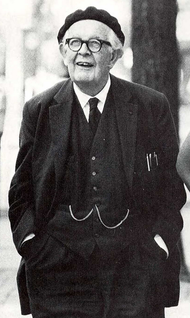让·皮亚杰
| 让·威廉·弗里兹·皮亚杰 | |
|---|---|
 | |
| 出生 | 1896年8月9日 瑞士纽沙特 |
| 逝世 | 1980年9月16日(84岁) 瑞士日内瓦 |
| 知名于 | 建构主义、发生认识论、认知发展论、物体恒存概念、自我中心主义 |
| 科学生涯 | |
| 研究领域 | 发展心理学、知识论 |
| 受影响自 | 伊曼努尔·康德、亨利·柏格森、皮耶·珍尼特、詹姆斯·马克·鲍德温 |
| 施影响于 | 巴贝尔·英海尔德、杰若米·布鲁纳、劳伦斯·柯尔伯格、哈沃德·加德纳、汤玛斯·孔恩、西摩尔·派普特、安伯托·艾柯 |
让·皮亚杰(法语:Jean Piaget,1896年8月9日—1980年9月16日),全名让·威廉·弗里兹·皮亚杰(法语:Jean William Fritz Piaget),瑞士人,是近代最有名的发展心理学家,同时也是哲学家。他的认知发展理论成为了这个学科的典范。皮亚杰早年接受生物学的训练,他在大学读书时就已经开始对心理学有兴趣,并曾涉猎心理学早期发展的各个学派如病理心理学、精神分析学、荣格的潜意识心理学和弗洛伊德的学说。皮亚杰从1929年到1975年在日内瓦大学担任心理学教授。
生平
[编辑]皮亚杰出生在瑞士法语区的纳沙泰尔,父亲亚瑟是纳沙泰尔大学的中世纪文学教授。他是个早熟的孩子,对生物学,特别是软体动物很有兴趣,中学毕业之前在这方面已经发表了许多论文。他漫长的科学生涯开始于1907年他11岁时发表关于患白化病的麻雀的短文。此后70年中他写了60多本书和一千五百篇多论文。
这时他从瑞士搬到法国,在Grange-aux-Belles 阿尔弗雷德·比奈(比奈智力测验的发明者)开办的男校教书。1921年,他回到瑞士,担任日内瓦卢梭学会会长。
1923年,他和Valentine Châtenay结婚,他们的3个孩子都是他研究的对象。
认知发展阶段
[编辑]皮亚杰最著名的学说,是他把儿童的认知发展分成以下四个阶段:
- 感知运动阶段(感觉-动作期,Sensorimotor, 0-2岁)靠感觉获取经验。1岁时发展出物体恒存的概念,以感觉动作发挥图式的功能;
- 前运算阶段(前运思期,Preoperational, 2-7岁)已经能使用语言及符号等表征外在事物,具推理能力但不符逻辑,不具保留概念,缺乏可逆性,以自我为中心,直接推理,集中注意力,
- 具体运算阶段(具体运思期,Concrete Operational, 7-11岁)了解水平线概念,能使用具体物之操作来协助思考;
- 形式运算阶段(形式运思期,Formal Operational, 11-16岁)开始会类推,有逻辑思维和抽象思维。
这四个阶段有以下的特色:
- 发展顺序不变,但具有个别差异。
- 具有普遍性(不具文化特别性)。
- 依赖认知发展,但可普遍化为其它功能。
- 各发展阶段都是在逻辑上有组织的整体。
- 各阶段的顺序是自然的阶层(所有成功发展的阶段都会有前面阶段的元素参与合作,但后一阶段比起前面的阶段,更加不同,而且更加统整)。
- 每个阶段,在思考模式上会表现出质的不同,而不仅仅是量的差异。
皮亚杰提出认知发展过程或建构过程有四个核心概念:
- 基模(图式)(schemas):将知识形像化,成为一个概念模型。知识可以透过同化或顺化来达成。
- 同化(assimilating):将新知识和旧有知识类比,并作出关连。
- 调适(顺化,accommodating):将旧知识的概念模型改变调适,以容纳新的内容。
- 平衡(equilibrium)
这种形像化过程不会完全只有同化或顺化的过程,而是两者之间的一个平衡点。找出这个平衡点的过程就是平衡。平衡有三种:
- 第一种平衡是同化和顺化之间的联系。
- 第二种平衡是基模与基模之间的平衡。
- 第三种平衡是一种调节个体部分知识与整体知识之间关系的平衡。
虽然皮亚杰的理论有部分跟维高斯基(Vygotzky)的理论相似,但相信皮亚杰的理论应该跟维高斯基的理论没有关连。 皮亚杰的发展心理学理论广泛流传。在其中,哲学家,也是社会理论家的哈贝马斯将皮亚杰的理论结合到他的研究中,而以沟通行动论闻名。
皮亚杰的儿童心理观
[编辑]皮亚杰把儿童看成建造自己的个人知识理论的小哲学家和科学家。
影响
[编辑]教育领域
[编辑]计算机科学和人工智能领域
[编辑]西摩尔·派普特就是根据皮亚杰的理论而开发了可供儿童学习使用电脑的Logo编程语言。Alan Kay以皮亚杰的理论为基础,开发了Dynabook编程概念。以上这两项技术,都是现今我们日常使用的图形使用者界面(GUI)的基础技术,使电脑从文字界面过渡至图形界面,改写了电脑技术的发展路向。
主要著作与成就
[编辑]主要著作
[编辑]- (1929)·“儿童关于世界的概念”.英国
- (1958). 从童年到青春期逻辑思维的发展.纽约:Basic Books.
- (1962). 儿童心理学.纽约:Basic Books
- (1962). 童年的游戏、梦和模仿.纽约:Norton.
- (1970). 结构主义.纽约:Harper & Row.
- (1971). 生物学和知识.芝加哥大学出版社.
- Piaget, J. (1983). "皮亚杰理论". In P. Mussen (ed). 儿童心理学手册.第4版. Vol. 1.纽约:Wiley.
- (1995). 社会学研究.伦敦:Routledge.
- (2000). "维果斯基评论". 心理学新观念, 18, 241-59.
- (2001). 反射抽象研究.英国霍夫:心理学出版社。
职位
[编辑]- 1921-25 日内瓦卢梭学会会长
- 1925-29 纳沙特尔大学心理学、社会学和哲学教授
- 1929-39 日内瓦大学科学思想史教授
- 1929-67 日内瓦国际教育署局长
- 1932-71 日内瓦大学教育科学学会会长
- 1938-51 洛桑大学实验心理学和社会学教授
- 1939-51 日内瓦大学社会学教授
- 1940-71 日内瓦大学实验心理学教授
- 1952-64 巴黎大学发生心理学教授
- 1955-80 日内瓦国际发生认识论中心主任
- 1971-80 日内瓦大学荣誉教授
延伸阅读
[编辑]- Aqueci, F. (2003). Ordine e trasformazione: morale, mente, discorso in Piaget. Acireale-Roma: Bonanno. ISBN 88-7796-148-1.
- Amann-Gainotti, M.; Ducret, J.-J. Jean Piaget, disciple of Pierre Janet: Influence of behavior psychology and relations with psychoanalysis. Information Psychiatrique. 1992, 68: 598–606.
- Beilin, H. Piaget's enduring contribution to developmental psychology. Developmental Psychology. 1992, 28 (2): 191–204 [2021-06-20]. S2CID 14459165. doi:10.1037/0012-1649.28.2.191. (原始内容存档于2019-12-16).
- Beilin, H. (1994). Jean Piaget's enduring contribution to developmental psychology. A century of developmental psychology (pp. 257–290). Washington, DC US: American Psychological Association.
- Bringuier, J.-C. (1980). Conversations with Jean Piaget (B.M. Gulati, Trans.). Chicago: University of Chicago Press. (Original work published 1977) ISBN 0-226-07503-6.
- Chapman, M. (1988). Constructive evolution: Origins and development of Piaget's thought. Cambridge: Cambridge University Press. ISBN 0-521-36712-3.
- Demetriou, A. (1998). Cognitive development. In A. Demetriou, W. Doise, K. F. M. van Lieshout (Eds.), Life-span developmental psychology (pp. 179–269). London: Wiley.
- Demetriou, A., Mouyi, A., & Spanoudis, G. (2010). The development of mental processing. Nesselroade, J. R. (2010). Methods in the study of life-span human development: Issues and answers. In W. F. Overton (Ed.), Biology, cognition and methods across the life-span. Volume 1 of the Handbook of life-span development (pp. 36–55), Editor-in-chief: R. M. Lerner. Hoboken, NJ: Wiley.
- Duveen, G. & Psaltis, C. (2008). The constructive role of asymmetries in social interaction. In U. Mueller, J. I. M. Carpendale, N. Budwig & B. Sokol (Eds.), Social life and social knowledge: Toward a process account of development. Mahwah, NJ: Lawrence Erlbaum.
- Flavell, J. (1967). The developmental psychology of Jean Piaget. New York: D. Van Nostrand Company. ISBN 0-442-02413-4.
- Fowler, J. W. (1981). Stages of faith: The psychology of human development and the quest for meaning. San Francisco: Harper & Row. ISBN 0-06-062866-9.
- Gattico, E. (2001). Jean Piaget. Milano: Bruno Mondadori. ISBN 88-424-9741-X.
- Hallpike, C.R. (1979). The foundations of primitive thought. Oxford: Oxford University Press. ISBN 0-19-823196-2.
- Ivey, A. (1986). Developmental therapy. San Francisco: Jossey-Bass. ISBN 1-55542-022-2.
- Kamii, C. (1985). Young children reinvent arithmetic: Implications of Piaget's theory. New York: Teachers College Press.
- Kesselring, T. (1999). Jean Piaget. München: Beck. ISBN 3-406-44512-8.
- Kassotakis, M. & Flouris, G. (2006) Μάθηση & Διδασκαλία, Αthens.
- Kitchener, R. (1986). Piaget's theory of knowledge: Genetic epistemology & scientific reason. New Haven: Yale University Press. ISBN 0-300-03579-9.
- Kose, G. A philosopher's conception of Piaget: Piagetian theory reconsidered. Theoretical & Philosophical Psychology. 1987, 7 (1): 52–57. doi:10.1037/h0091442.
- Mayer, S. The early evolution of Jean Piaget's clinical method. History of Psychology. 2005, 8 (4): 362–382. PMID 17152748. doi:10.1037/1093-4510.8.4.362.
- Messerly, J.G. (1992). Piaget's conception of evolution: Beyond Darwin and Lamarck. Lanham, MD: Rowman & Littlefield. ISBN 0-8476-8243-9.
- Psaltis, C.; Duveen, G. Social relations and cognitive development: The influence of conversation type and representations of gender. European Journal of Social Psychology. 2006, 36 (3): 407–430. doi:10.1002/ejsp.308.
- Psaltis, C.; Duveen, G. Conversation types and conservation: Forms of recognition and cognitive development. British Journal of Developmental Psychology. 2007, 25 (1): 79–102. doi:10.1348/026151005X91415.
- Robinson, R.J. (2005). The birth of reason. Prometheus Research Group. (Available online at prometheus.org.uk (页面存档备份,存于互联网档案馆))
- Smith, L. (Ed.) (1992). Jean Piaget: Critical assessments (4 Vols.). London: Routledge. ISBN 0-415-04408-1.
- Smith, L. (1993). Necessary knowledge: Piagetian perspectives on constructivism. Hove, UK: Lawrence Erlbaum. ISBN 0-86377-270-6.
- Smith, L. (Ed.) (1996). Critical readings on Piaget. London: Routledge. ISBN 0-415-13317-3.
- Smith, L. (2001). Jean Piaget. In J. A. Palmer (Ed.), 50 modern thinkers on education: From Piaget to the present. London: Routledge.
ondwelle.com (页面存档备份,存于互联网档案馆) [Also in French: ondwelle.com (页面存档备份,存于互联网档案馆)
- Vidal, F. (1994). Piaget before Piaget. Cambridge, MA: Harvard University Press. ISBN 0-674-66716-6.
- Vonèche, J.J. (1985). Genetic epistemology: Piaget's theory. In T. Husén & T.N. Postlethwaite (Eds.-in-chief), International encyclopedia of education (Vol. 4). Oxford: Pergamon.
- Wynn, T. The intelligence of later Acheulean hominids. Man. New Series. 1979, 14 (3): 371–391. JSTOR 2801865. doi:10.2307/2801865.
- Wynn, T. The intelligence of Oldowan hominids. Journal of Human Evolution. 1981, 10 (7): 529–541. doi:10.1016/S0047-2484(81)80046-2.
参见
[编辑]外部链接
[编辑]- 瑞士日内瓦大学的皮亚杰论文库(页面存档备份,存于互联网档案馆)
- 皮亚杰协会(页面存档备份,存于互联网档案馆).
- 皮亚杰的发生认识论:欣赏与批评
- The Construction of Reality in the Child(页面存档备份,存于互联网档案馆),皮亚杰(1955)
- 发生认识论(页面存档备份,存于互联网档案馆),皮亚杰(1968)
- 维果斯基评论(页面存档备份,存于互联网档案馆),皮亚杰(1962)
| ||||||||||||||||||||||||||||||||||||||||||
| ||||||||||||||||||||||||||||||||
Text is available under the CC BY-SA 4.0 license; additional terms may apply.
Images, videos and audio are available under their respective licenses.
